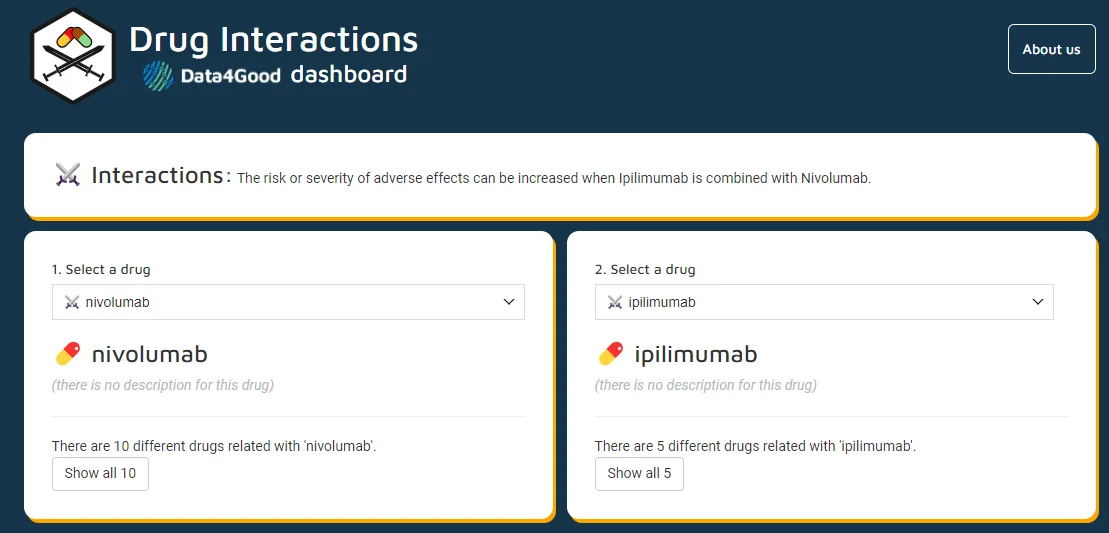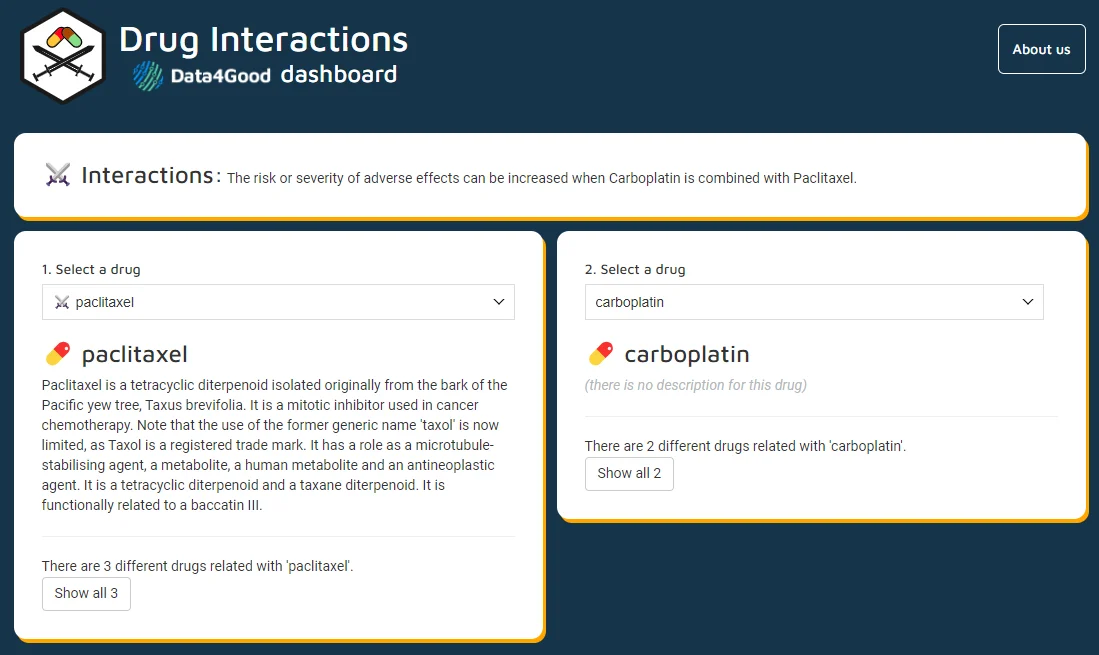

Exploring Pharmacokinetic and Pharmacodynamic Drug-Drug Interactions with our Drug Interactions Shiny App
In the field of oncology, in-depth research into and comprehension of drug-drug interactions hold paramount significance. This is especially crucial given the limited margin between the effective and toxic doses of anticancer agents.
In this article, we discuss what drug interaction is, the different kinds, and take a look into some of these interactions through our drug interactions Shiny app.
What is a Drug Interaction?
Drug interactions are reactions between two (or more) drugs or between a drug and another element, such as food or supplements. Drug interactions are important because they can cause unwanted side effects. They can also increase or reduce the action of a particular drug.
🚨 Important Note
The text presented here does not represent medical advice. Always consult with your doctor in health-related matters. Our application purely presents data from the US National Library of Medicine and the National Institute of Health datasets.
Table of Contents
- What is a Drug Interaction?
- 🚨 Important Note
- What Kind of Drug Interactions Can Occur?
- A Quick Peek into Our Drug Interactions Shiny App
- Pharmacokinetic Interactions
- Pharmacodynamic Interactions
- A Journey to Transform Life Sciences: Tapping into the Power of R/Shiny Technology
What Kind of Drug Interactions Can Occur?
According to the FDA, these types of interactions fall into three categories:
- Drug-drug interactions: This happens when two or more drugs interact with each other.
- Drug-food/beverage interaction: This is the result of a drug reacting with food or beverages.
- Drug-condition interaction: This type occurs when a pre-existing medical condition makes a particular drug potentially harmful.
Drugs can interact at two levels: pharmacokinetic and pharmacodynamic.
We will explore a few important drug interactions and will analyze them using our Drug Interactions Shiny App.
A Quick Peek into Our Drug Interactions Shiny App
The app fundamentally simplifies information access by removing the intricacy of navigating various databases and sorting through pertinent data. Additionally, the secondary drug search box displays any high-severity interactions that may be present.
Pharmacokinetic Interactions
When an interaction at the pharmacokinetic level occurs, it means that a drug alters how the other is absorbed, distributed, metabolized or excreted; this results in an increased or decreased drug concentration in the body that is available to produce a pharmacological effect.
Absorption interactions
Warfarin and Cholestyramine

Drug Interactions Dashboard: Warfarin and Cholestyramine
The information that we got from analyzing this interaction in our app is the following: cholestyramine may cause a decrease in the absorption of Warfarin, resulting in a reduced serum concentration and potentially a decrease in efficacy.
Mechanism of Interaction
According to a scientific study, cholestyramine treatment (4g three times daily) decreased the biological half-life of plasma warfarin and increased the total clearance of this drug. Also, the total anticoagulant effect per dose of warfarin, measured by the area under the effect v time curve, was also reduced by 25 % when cholestyramine was administered.
Distribution Interactions
Phenytoin and Valproic Acid

Drug Interactions Dashboard: Phenytoin and Valproic acid
Once we select these two drugs in our application, the following drug interaction is displayed: the serum concentration of Phenytoin can be decreased when it is combined with Valproic acid.
Mechanism of interaction
In a scientific study, the effect of sodium valproate on the disposition kinetics of intravenous phenytoin was investigated in a group of normal subjects. They found that after valproate, the free (unbound) fraction of phenytoin in serum rose from 9.6 % to 15.6 % on average (p < 0.001). The free phenytoin concentration in serum and phenytoin concentration in saliva increased during valproate administration.
The researchers’ results suggested that valproic acid administration may have two separate and opposing effects on phenytoin disposition:
- Displacing phenytoin from plasma protein binding sites, thus enhancing the systemic clearance of the total drug.
- Inhibition of phenytoin metabolism, thus increasing the concentration of free drug in the serum.
This interaction, which results in an increase in the free fraction of phenytoin, alters the relationship between total phenytoin concentration and the drug’s pharmacological effect. This results in toxicity at concentrations usually considered to be within the therapeutic range.
A case study showcasing the clinical outcomes of this interaction was reported. In this case study, the patient presented phenytoin toxicity despite receiving the appropriate administration of phenytoin.
Metabolism Interactions
Ethinylestradiol and Rifampin

Drug Interactions Dashboard: Ethinyl estradiol and Rifampin
Our application shows one interaction: the metabolism of Ethinylestradiol can be increased when combined with Rifampin.
Mechanism of Interaction
According to a scientific publication, ethinylestradiol is the most common estrogen found in oral contraceptive preparations. The main metabolic pathway of this estrogen is hydroxylation (by the cytochrome P450 IIIA4 or CYP3A4), and a minor pathway is conjugation, which results in sulphation or glucuronidation of the original steroid. The resulting conjugates reach the small intestine, where hydrolytic enzymes of intestinal bacteria break them down, which results in the release of active estrogenic hormone.
Antibiotics could diminish the efficacy of oral contraceptives, such as ethinylestradiol, by two main mechanisms:
- By interfering with the enterohepatic cycling of ethinylestradiol.
- By inducing a group of hepatic microsomal enzymes of the cytochrome P450.
The former is considered to be the most clinically important. Rifampin induces enzymes of the cytochrome P450 in the liver, which results in an increased hepatic hydroxylation of estrogens by fourfold. This results in both a reduction in the area under the curve (AUC) and increased clearance.
Excretion Interactions
Methotrexate and Ibuprofen

Drug Interactions: Methotrexate and Ibuprofen
By using our application to analyze possible interactions between these two drugs, we can observe the following: the serum concentration of methotrexate can be increased when it is combined with ibuprofen.
Mechanism of Interaction
Common over-the-counter nonsteroidal anti-inflammatory drugs (NSAIDs) include: aspirin, ibuprofen and naproxen sodium. Several NSAIDs, including ibuprofen, have been shown to reduce renal clearance of methotrexate, which could lead to toxicity (i.e., renal failure), when methotrexate is administered at high doses.
A scientific research investigated the pharmacokinetics of methotrexate in patients with rheumatoid arthritis concurrently treated with NSAIDs. They found that the apparent systemic clearance of methotrexate was significantly reduced by the treatment with NSAIDs, including ibuprofen. Ibuprofen significantly reduced methotrexate renal clearance. This data showed that NSAIDs can affect the disposition of methotrexate and increase its toxicity.
In another study, the findings indicated that there is a lack of significant interaction between low-dose methotrexate and ibuprofen in patients with arthritis when using up to 25 mg/dose and 2400 mg/day of ibuprofen.
The results of these studies show that for some drug interactions, it’s really important to consider the doses being administered or studied.
Pharmacodynamic Interactions
This type of interaction occurs when two or more administered drugs have similar or antagonistic pharmacological properties.
When two or more drugs have similar mechanisms of action, their interaction is known as additive or synergistic.
Synergy is commonly defined as the effect of two or more agents working in combination that is greater than the expected additive effect of said agents.
An additivity interaction occurs when the overall effect caused by a drug combination is the sum of the pharmacological effects of each individual agent in the combination.
When two or more drugs have antagonistic properties, these drugs compete to interact with their targeted receptor. This type of interaction is known as antagonistic interaction. When the effect of one drug is impeded by another, the effects of these drugs are antagonistic.
A Possible Synergistic or Additive interaction
Nivolumab and Ipilimumab

Drug Interactions Dashboard: Nivolumab and Ipilimumab
Our Shiny application shows that the risk or severity of adverse effects can be increased when Ipilimumab is combined with Nivolumab. Cancer immunotherapy has demonstrated great clinical success. Whether a combination of multiple inhibitors provides a synergistic or additive effect requires further clinical investigation.
Adverse Events – Mechanism of Interaction
Nivolumab is a type of targeted therapy drug called an immune checkpoint inhibitor (ICI) (a type of immunotherapy). It is a monoclonal antibody that binds to the protein programmed death 1 (PD-1) on the surface of T cells. It works by keeping cancer cells from suppressing the immune system. This allows the immune system to attack and kill the cancer cells.
Ipilimumab is also an immune checkpoint inhibitor. It is a monoclonal antibody that binds to the protein cytotoxic T-lymphocyte-associated antigen 4 (CTLA-4) on T cells. It also prevents cancer cells from suppressing the immune system.
The occurrence of serious adverse events seen during the treatment with immune checkpoint inhibitors are related to excessive immune activation, something collectively known as immune-related adverse events (irAEs). The combination of anti-CTLA-4 antibody and anti-PD-1 antibody increases both the incidence and severity of irAEs. The mechanism of ICI- induced irAEs varies according to the affected organ.
Synergistic or Additive effect – Possible Mechanism of Interaction
PD-1 inhibitors (such as Nivolumab) affect T cell inflammation in inflamed tissues (i.e., in the tumor microenvironment). CTLA-4 inhibitors target T cells at sites of priming (i.e., tumor draining lymph nodes). Due to the distinct mechanisms of action, the combination of these two ICIs can boost anticancer immune response at different times and locations throughout T cell evolution.
Antagonistic Interaction
Paclitaxel with Carboplatin

Drug Interactions Dashboard: Paclitaxel with Carboplatin
The application shows the following: The risk or severity of adverse effects can be increased when Carboplatin is combined with Paclitaxel.
This is a commonly interacting combination among chemotherapeutic drugs; this combination is commonly used for treating multiple solid tumours.
Mechanism of Interaction
The interaction effect is mainly due to cell cycle-dependent antagonistic interactions. The mechanism is that pretreatment or co-treatment of Carboplatin inhibits the paclitaxel-induced I-kappa B-alpha degradation and bcl-2 phosphorylation. Also, Paclitaxel’s cytotoxic effects on both mitotic arrest and apoptotic cell death could interfere with carboplatin administration.
A Journey to Transform Life Sciences: Tapping into the Power of R/Shiny Technology
In conclusion, our journey through pharmacokinetic and pharmacodynamic drug-drug interactions has been incredibly illuminating, thanks to the power of our Drug Interactions Shiny App.
At Appsilon, we recognize the immense potential of R/Shiny as a transformative tool in the realm of Life Sciences. By leveraging its capabilities, we stand at the forefront of advancing discoveries in this field.
R/Shiny allows us to create intuitive, interactive, and user-friendly interfaces, allowing researchers and professionals to delve deep into complex data effortlessly. Its flexibility enables us to adapt swiftly to evolving research needs, fostering a dynamic environment for discovery and innovation.
Bring Appsilon on board for Expert Enterprise-Level R/Shiny Application Development.






